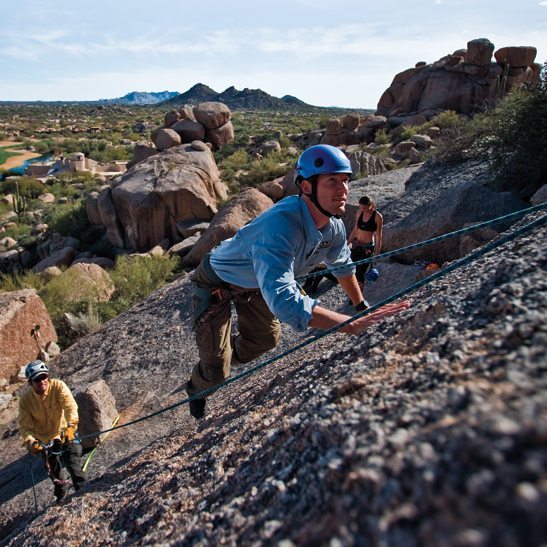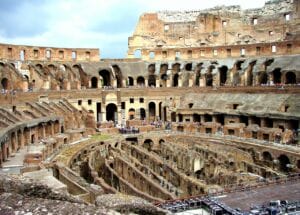For years, state tourism and hospitality enjoyed a healthy dose of success. As the population boomed, so did travel, with out-of-state visitors increasing steadily from 2002 through 2007. But the recession, coupled with a decline in corporate meetings, made 2009 a very difficult year for the tourism and hospitality industry.
Arizona resorts and hotels that promoted staycations as a way to ride out the slow summer months, are now counting on them year-round to remain viable until the economy improves significantly.
“It’s not either/or; what we’re trying to communicate is that a staycation IS a vacation.”
– Debbie Johnson, Arizona Hotel & Lodging Association
“We are seeing more local and regional business to the resort throughout the entire year than ever before,” says Michael Stephens, general manager of the Hyatt Regency Scottsdale. “If ever there was a time to take advantage of some really great offers in-season, this is the year.”
To stimulate in-state travel and help ease the pain of a sharp decline in occupancy, local tourism representatives are turning to residents and spreading the message about the allure of staycations.
“Staycations have been and will continue to be one of the vacation elements that many of our state residents enjoy,” says Rachel Sacco, president and CEO of the Scottsdale Convention & Visitors Bureau. “It’s such a rewarding experience. Throw something in the car and go, but you feel like you’re a million miles away.”
Industry insiders hope that by providing extra incentives and cost-saving measures to local travelers, tourism will get the boost it needs to get through the economic downturn.
“If embraced and harnessed correctly, tourism is the state’s strongest weapon against further economic woes,” says Debbie Johnson, president and CEO of the Arizona Hotel & Lodging Association. “If you’re tired of the economic slump and wish you could do something about it — take a trip, go out to a restaurant, and change the way we think about companies holding meetings. It’s the best way to personally affect the economy and get us moving back in the right direction.”
And the local market is one that can be deeply mined. According to the Arizona Office of Tourism’s (AZOT) year-end summary, the second largest tourist segment was comprised of state residents, with 9.8 million overnight visitors. Although domestic non-residents still made up the largest share of overnight visitors, Arizonans logged an impressive 33 percent of the state’s domestic overnight visitors in 2008.
Industry professionals are sending the message to locals that a staycation is a cost-effective alternative to out-of-state travel — no matter the season.
“Why spend tons of time and money on flights or inflated gas prices when we have such an incredibly diverse state with attractions and amenities that other people travel the globe to experience,” Johnson asks. “It’s not either/or; what we’re trying to communicate is that a staycation IS a vacation.”
Economic Impact
In AZOT’s year-end summary it was reported that direct travel spending in Arizona in 2008 was $18.5 billion. Travel spending also generated 166,900 direct jobs paying $5 billion in earnings. The report also stated that Arizona visitors staying overnight in paid lodging accounted for 41.2 percent of all visitor spending in 2008.
“Choosing a staycation keeps hard-earned money in our state, which generates tax revenues that trickle through the entire Arizona economy,” says Jennifer Wesselhoff, president and CEO of the Sedona Chamber of Commerce.
From the Greater Phoenix area to Tucson and Flagstaff, in-state travel is important to every county, although some rely on it more than others. According to AZOT, travel spending is more critical to the economies of Arizona’s rural counties.
To help Arizona communities and tribal entities with their tourism development and marketing efforts, AZOT is coordinating an educational outreach program called Arizona Tourism University. The university conducts free workshops on tourism topics and offers advice on marketing plans, style guidelines and more.
Last year, AZOT also partnered with the Arizona Hotel & Lodging Association to launch a Web site, www.valueaz.com, dedicated to helping individuals find the best travel deals available.
“We’re trying to help our members get the word out about their great deals, and educate residents that they can and should feel good about spending their money on in-state travel,” says Johnson, who is also president and CEO of the Valley Hotel and Resort Association in addition to serving as the executive director of the Arizona Tourism Alliance.
Deals for Locals
Along with the limping economy, a sharp drop in corporate meetings since 2008 has forced resorts to diversify their brands and market staycations. To that end, hospitality establishments across the Valley and state are pushing incentives aimed at the local community.
“We have chosen to be creative in positioning ourselves with a variety of different package options,” says Michael Hoffman, managing director of the Boulders Resort & Golden Door Spa.
The Boulders has created a series of adult-centered activities, including rock climbing, hiking and spa treatments, to lure Arizona’s adult community.
Even resorts that are synonymous with exclusive luxury are now a more affordable option for locals.
“The staycation enhances our business,” says David Richard, area director of sales and marketing for Starwood Hotels, a hotel and leisure company that owns the Phoenician. “(Staycations) are more important than ever in building occupancy. They serve as a catalyst for increasing business across the entire resort.”
Richard also notes that staycations allow the local community to experience the Phoenician at a much more attractive price point.
And the Valley staple is not the only high-end resort to recognize the importance of attracting residents during these dismal economic times. The Arizona Biltmore — a presence in the Valley since 1929 — also has set its sights on increasing its staycation market.
“We actually started marketing toward the Arizona market even before the downturn,” says Andrew Stegen, general manager of the Arizona Biltmore.
In addition to traditional advertising, the Biltmore has successfully utilized social media and Internet specials as a way of alerting locals about deals and promotions.
“It creates an opportunity for a lot of people to visit our resorts who in other circumstances see it as inaccessible because of price,” Stegen says.
Beginning on May 22, summer rates for the luxurious resort start at $99 a night. In addition to these reduced rates, the Biltmore offers numerous cost-saving options, including all-inclusive golf packages, spa specials and restaurant deals. Stegen is certain that with more exposure, staycations will change the way residents view travel.
“It’s helped us introduce a great luxury product to people who have not thought of us as a vacation destination before,” he asserts.
The Sanctuary Camelback Mountain Resort & Spa also has developed many promotional efforts focusing on staycations. Special deals are e-mailed exclusively to individuals who follow the resort online.
“The value is so great right now,” says Michael Surguine, general manager of the Sanctuary. “(With a staycation) you wind up getting a lot more vacation hours for your buck.”
Another resort offering incentives to residents is the Hyatt Regency Scottsdale Resort and Spa at Gainey Ranch. Last year, the resort launched its Shades of Summer program, which offered deals to families, including free meals, Camp Hyatt activities for kids and giveaways. The resort is planning to have similar incentives this summer.
“Our success was really built on adding value,” aknowledges Michael Stephens of the Hyatt Regency Scottsdale. “I will say that the Hyatt Regency Scottsdale has never been this affordable all year round than this year.”
Arizona Amenities
Thanks to the deals now being offered at local hotels and resorts, Arizonans can take advantage of the state’s abundant natural endowments. According to AZOT, exploring the state’s wonders is one of the top activities for resident travelers. Overnight residents were more likely to take part in hiking or backpacking — 15.1 percent versus 11.4 percent for overnight, non-resident tourists. Residents also led the pack in camping and fishing activities.
“Our diversity offers everything from the desert, lush forests, riparian terrain and mountains, to lakes and streams, and some of the most beautiful backdrops in the Southwest,” says Wessellhoff of the Sedona Chamber of Commerce.
Wessellhoff adds that while staycations help Arizonans save money, they also allow residents to experience things they typically take for granted or simply never had time to fully appreciate before.
Heather Ainardi, director of the Flagstaff Convention & Visitors Bureau agrees: “In economic downturns, people often look for more ‘real’ and natural experiences, and Arizona is very well positioned to offer travelers an authentic experience.”
The Future of Staycations
While the economy begins its slow trek back, staycations remain a viable option for local individuals and families looking for a special travel experience at affordable prices.
More importantly, it is this type of local travel that can stimulate the hospitality industry and help it survive the recessionary downturn. From Phoenix residents escaping the summer heat of the Valley for a cooler retreat in Flagstaff or Sedona to Tucsonans heading to the Valley’s golf resorts and restaurants — every destination has something to offer local travelers.
“Regardless of the economic climate, or perhaps because of it, people will want to get away from it all and enjoy some leisure time,” says Richard of Starwood Hotels.




